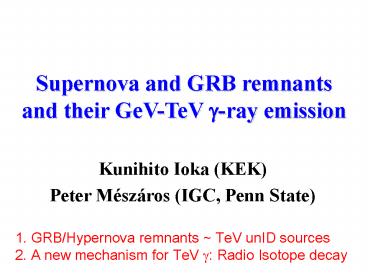Supernova and GRB remnants and their GeVTeV gray emission - PowerPoint PPT Presentation
Title:
Supernova and GRB remnants and their GeVTeV gray emission
Description:
TeV unidentified (TeV unID) sources. No counterpart, Origin unknown ... isotropic ~200 keV, nonthermal. 10-3s~103s : Short, Long. GRB. Afterglow. X. Opt. Radio ... – PowerPoint PPT presentation
Number of Views:45
Avg rating:3.0/5.0
Title: Supernova and GRB remnants and their GeVTeV gray emission
1
Supernova and GRB remnantsand their GeV-TeV
g-ray emission
- Kunihito Ioka (KEK)
- Peter Mészáros (IGC, Penn State)
1. GRB/Hypernova remnants TeV unID sources 2. A
new mechanism for TeV g Radio Isotope decay
2
Contents
TeV unidentified (TeV unID) sources No
counterpart, Origin unknown Gamma-Ray Burst
(GRB) GRB-Supernova/Hypernova GRB/Hypernova
remnant-TeV unID 1. p0 decay Nobs(HNR)Nobs(SNR)
2. b decay e-Inverse Compton 3. Radio
isotope (RI) decay
3
Multi-wavelength sky
Radio
IR
Opt
X
g
New wavelength?New sources (GRB, pulsar, )
4
Increasing TeV sources
Kifune plot
Jim Hinton, rapporteurtalk, ICRC 2007
Most abundant category unID! No clear
counterparts at other wavelengths
5
HESS Galactic survey
6
Observed properties
TeV unID
Disk ? Galactic origin
Aha 06
Extended
7
TeV g-ray
Leptonic process (e with 10-100TeV) Synchrotron?X
Inverse Compton?g
Electron acceleration
Synchrotron (X)
Magnetic Field
Inverse Compton (g)
CMB g
Hadronic process (p with 10-100TeV) pp?p0
decay?2g
Proton acceleration
p0
2g
Nucleus
p
8
SNR
Koyama 05
Bamba 03
CR acceleration at SN shock
Most likely Galactic CR origin Also likely TeV g
sources
Hwang 04
Aha 04
9
Suzaku upper limit
Suzaku?Strong X-ray upper limit FTeV/FXgt50 ?
Leptonic Hadronic ? ? Young SNR
TeV g
X-ray
Matsumoto 07
Bamba 07
10
Old SNR?
In old SNRs, emax,electron is low but p0 g
fluxconst ? FTeV/FXgt100
Yamazaki 06
TeV
X
But, Rate1/100yr?103 SNR ? 10 unID
11
GRB Rare SN
Luminosity
The most luminous objects 1051erg/s
gtmsec
Afterglow
GRB
X Opt Radio
Redshift
1000 events/yr isotropic 200 keV,
nonthermal 10-3s103s Short, Long
SN
1day
Time
12
Standard model
optically thick gg?ee-
Internal shock
SN?
?
ISM
Ggt100
External shock
Central Engine
??
Afterglow
Kinetic energy ? Shock dissipation
GRB
??
13
GRB-SN
Hjorth(03)
Afterglow Light curve
Type Ic spectrum
Bloom(99)
? GRB is associated with SN Ibc
14
Collapsar
Jet breaks out the massive stellar envelope
15
GRB/Hypernova
Hypernove (hyper-energetic SNe) occur more
frequently than GRBs
EHN1052erg RSN1/100yr RHN1/104yr RGRB1/105yr
tage105yr ? NHN10NunID
Nomoto
16
Old GRB/HN remnant
g-ray Flux for pp?p0?2g
Just by scaling the SNR calculations
FunID
CR energy1051erg10x1052erg
Flux t-independent ? Old ones are dominated ?
leptonic emission is weak (low emax,e) ? unID
Number
Size
R1/104yr tage105yr ? NHN10NunID
17
Observed number ratio
Observed (HNR)Observed (SNR)
? 10 times energy ? dmax?E1/2 ? Sensitivity to
extended sources?(size)?d-1 ? dmax?E ?
Volume?dmax2?E2
Observable SNRs are nearby ? Size is too large?
18
GRB jet-Cosmic Ray
SN shock
Hillas diagram
B
GRB
EltZeBR
Internal shock
External shock
also accelerate cosmic ray
R
RGRB1/105yr ? NGRB1 but recent obs.
suggest RGRB w/ slow jet1/104yrRHN
19
GRB remnant (GRBR)
Loeb Perna 98 Wick, Dermer Atoyan 04 Dermer
Atoyan 06
After non-rela ? Jet?Sphere ? GRBRSNR hydrodynami
cally (cf., RE1/5) Metal distribution could be
different
Ayal Piran 01
20
1. p0 decay
HESS J1301-631
SNR
All
Atoyan, Buckley Krawczynski 06
Relativistic souces ? less particle _at_ low E ? Low
GeV Radio emission
21
2. b decay e-IC
ep1016g7eV
tdecay900s
pg?np
g (CMB, )
Energy fraction of TeV g
KI, Kobayashi Mészáros 04
22
Unique morphology
KI, Kobayashi Mészáros 04
W49B
SNR
Elongated emission outside SNR Age/Energy
dependent profile
Less e _at_ low E Dim _at_GeV radio
23
Candidate?
Aha 06
24
3. Radio isotope (RI) decay
56Ni ? SN light curve
1998bw M(56Ni)0.4M?
2MeV
Could be shock-accelerated before decay (by
reverse shock?)
No need for target g and matter
25
SN light RI decay
NS/BH
Nomoto07
56Ni, 56Co decay ?SN light curve
Complete Si burning?56Ni Fall back to central
BH/NS
26
Fe(56Ni)
O
Woosley Zhang 07
Mazzali05
27
RI decay model
56Co case
56Co energy
GRB jet OK
SNR disappears
Energy fraction of TeV g
energetic GRB
28
Spectrum
tdecay106g6yr egTeVg6
t
nFn
n(2-p)-1
Exp. cutoff
Already decayed
Now decaying
GeV
TeV
n
29
RI model spectrum
105yr
p-2nd e
Radio
X
30
Fe ?
Auger
Depth of air shower maximum
31
Photo-disintegration
Murase,KI08
Wang, Razzaque Mészáros 07
Ni/Co/Fe can survive photo-disintegration (? Fe
UHECR implied by Auger Xmax)
32
Model identificaion
Neutrino
g Morphology
p0
No n (Already decayed)
b
RI
33
Summary
TeV unID sources Dominant in TeV sky, Origin
unknown Old GRB/Hypernova remnant
Nobs(HNR)Nobs(SNR) SNR may be more nearby and
extended BH in unID? A new mechanism for g-ray
production Decay of Accelerated Radio Isotope
(RI) No need for target matter or photon































